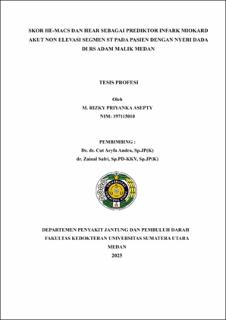Skor HE-MACS dan HEAR Sebagai Prediktor Infark Miokard Akut Non Elevasi Segmen ST Pada Pasien Dengan Nyeri Dada di RS Adam Malik Medan
HE-MACS and HEAR Score as Predictors of Acute Non-ST Segment Elevation Myocardial Infarction in Patients with Chest Pain at Adam Malik Hospital Medan

Date
2025Author
Asepty, M Rizky Priyanka
Advisor(s)
Andra, Cut Aryfa
Safri, Zainal
Metadata
Show full item recordAbstract
Objective:
Chest pain is one of the most common symptoms prompting patients to visit the Emergency Department (ED). This study aimed to evaluate the accuracy of the HE-MACS and HEAR scores as predictors of non-ST elevation acute myocardial infarction (NSTEMI) in patients presenting with chest pain at the ED of Adam Malik Hospital, Medan, to improve patient management efficiency and reduce the burden on the ED.
Methods:
This retrospective analytical study employed a cross-sectional design. The study sample consisted of 223 patients with chest pain who visited the ED of Adam Malik Hospital, Medan, and were diagnosed with acute coronary syndrome (ACS) without ST-segment elevation. Data were collected from medical records, including clinical history, electrocardiography (ECG) findings, and cardiac troponin levels. HEAR and HE-MACS scores were calculated for each patient and analyzed using the Receiver Operating Characteristic (ROC) curve to assess their predictive accuracy for NSTEMI.
Results:
The mean HEAR score was 5.48 (range: 3–9), while the mean HE-MACS score was 23.46 (range: 3.1–91.5). The HEAR score demonstrated a sensitivity of 79.6% and a specificity of 30%, with an optimal cutoff value of ≥5. The HE-MACS score showed a sensitivity of 63.7% and a specificity of 54.5%, with an optimal cutoff value of ≥19. The area under the curve (AUC) for the HEAR score was 61.2% (p=0.004), while for the HE-MACS score it was 63.2% (p=0.001). Both scores exhibited weak predictive ability but remained useful as adjunct tools for risk stratification of patients in the ED.
Conclusion:
The HEAR and HE-MACS scores play an important role in risk stratification for patients with chest pain in the ED, despite their limited predictive accuracy. The HEAR score is more sensitive, while the HE-MACS score is more specific. The use of these scores can assist in clinical decision-making, particularly in determining subsequent management for high-risk patients. Further research is needed to validate these findings and develop more accurate risk assessment tools.
Collections
- Master Theses [107]
